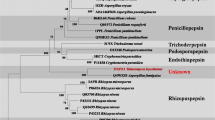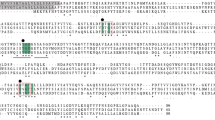Abstract
Prolyl peptidases of the MEROPS S28 family are of particular interest because they are key enzymes in the digestion of proline-rich peptides. A BLAST analysis of the Aspergillus oryzae genome revealed sequences coding for four proteases of the S28 family. Three of these proteases, AoS28A, AoS28B, and AoS28C, were previously characterized as acidic prolyl endopeptidases. The fourth protease, AoS28D, showed high sequence divergence with other S28 proteases and belongs to a phylogenetically distinct cluster together with orthologous proteases from other Aspergillus species. The objective of the present paper was to characterize AoS28D protease in terms of substrate specificity and activity. AoS28D produced by gene overexpression in A. oryzae and in Pichia pastoris was a 70-kDa glycoprotein with a 10-kDa sugar moiety. In contrast with other S28 proteases, AoS28D did not hydrolyze internal Pro-Xaa bonds of several tested peptides. Similarly, to human lysosomal Pro-Xaa carboxypeptidase, AoS28D demonstrated selectivity for cleaving C-terminal Pro-Xaa bonds which are resistant to carboxypeptidases of the S10 family concomitantly secreted by A. oryzae. Therefore, AoS28D could act in synergy with these enzymes during sequential degradation of a peptide from its C-terminus.




Similar content being viewed by others
References
Beggah S, Lechenne B, Reichard U, Foundling S, Monod M (2000) Intra- and intermolecular events direct the propeptide-mediated maturation of the Candida albicans secreted aspartic proteinase Sap 1p. Microbiology 146:2765–2773. doi:10.1099/00221287-146-11-2765
Borg-von Zepelin M, Beggah S, Boggian K, Sanglard D, Monod M (1998) The expression of the secreted aspartyl proteinases Sap4 to Sap6 from Candida albicans in murine macrophages. Mol Microbiol 28:543–554. doi:10.1046/j.1365-2958.1998.00815.x
Byun T, Kofod L, Blinkovsky A (2001) Synergistic action of an X-prolyl dipeptidyl aminopeptidase and a non-specific aminopeptidase in protein hydrolysis. J Agric Food Chem 49:2061–2063. doi:10.1021/jf001091m
Chakraborty BN, Patterson NA, Kapoor M (1991) An electroporation-based system for high-efficiency transformation of germinated conidia of filamentous fungi. Can J Microbiol 37:858–863. doi:10.1139/m91-147
Cove DJ (1966) The induction and repression of nitrate reductase in the fungus Aspergillus nidulans. Biochim Biophys Acta 113:51–56
Cunningham DF, O’Connor B (1997a) Proline specific peptidases. Biochim Biophys Acta - Protein Struct Mol Enzymol 1343:160–186. doi:10.1016/S0167-4838(97)00134-9
Cunningham DF, O’connor B (1997b) Identification and initial characterization of a N-benzyloxycarbonyl-prolyl-prolinal (Z-pro-prolinal)-insensitive 7-(N-benzyloxycarbonyl-glycyl-prolyl-amido)-4-methylcoumarin (Z-gly-pro-NH-mec)-hydrolysing peptidase in bovine serum. Eur J Biochem 244:900–903. doi:10.1111/j.1432-1033.1997.00900.x
Doumas A, Van Den Broek P, Affolter M, Monod M (1998) Characterization of the prolyl dipeptidyl peptidase gene (dppIV) from the Koji mold Aspergillus oryzae. Appl Environ Microbiol 64:4809–4815
Edens L, Dekker P, Van Der Hoeven R, Deen F, De Roos A, Floris R (2005) Extracellular prolyl endoprotease from Aspergillus niger and its use in the debittering of protein hydrolysates. J Agric Food Chem 53:7950–7957. doi:10.1021/jf050652c
Eugster PJ, Grouzmann E, Salamin K, Monod M (2015) Production and characterization of two major Aspergillus oryzae secreted prolyl endopeptidases able to efficiently digest proline-rich peptides of gliadin. Microbiology 161:2277–2288. doi:10.1099/mic.0.000198
Gascuel O (1997) BIONJ: an improved version of the NJ algorithm based on a simple model of sequence data. Mol Biol Evol 14:685–695. doi:10.1093/oxfordjournals.molbev.a025808
Guindon S, Dufayard JF, Lefort V, Anisimova M, Hordijk W, Gascuel O (2010) New algorithms and methods to estimate maximum-likelihood phylogenies: assessing the performance of PhyML 3.0. Syst Biol 59:307–321. doi:10.1093/sysbio/syq010
Hall T (1999) BioEdit: a user-friendly biological sequence alignment editor and analysis program for Windows 95/98/NT. Nucleic Acids Symp Ser 41:95–98
Huson DH, Scornavacca C (2012) Dendroscope 3: an interactive tool for rooted phylogenetic trees and networks. Syst Biol 61:1061–1067. doi:10.1093/sysbio/sys062
Kang C, Yu X-W, Xu Y (2015) Cloning and expression of a novel prolyl endopeptidase from Aspergillus oryzae and its application in beer stabilization. J Ind Microbiol Biotechnol 42:263–272. doi:10.1007/s10295-014-1571-8
Kitamoto N, Matsui J, Kawai Y, Kato A, Yoshino S, Ohmiya K, Tsukagoshi N (1998) Utilization of the TEF1-alpha gene (TEF1) promoter for expression of polygalacturonase genes, pgaA and pgaB, in Aspergillus oryzae. Appl Microbiol Biotechnol 50:85–92. doi:10.1007/s002530051260
LeBoeuf AC, Waridel P, Brent CS, Gonçalves AN, Menin L, Ortiz D, Riba-Grognuz O, Koto A, Soares ZG, Privman E, Miska EA, Benton R, Keller L (2016) Oral transfer of chemical cues, growth proteins and hormones in social insects. elife 5:e20375. doi:10.7554/eLife.20375
Lee BR, Furukawa M, Yamashita K, Kanasugi Y, Kawabata C, Hirano K, Ando K, Ichishima E (2003) Aorsin, a novel serine proteinase with trypsin-like specificity at acidic pH. Biochem J 371:541–548. doi:10.1042/BJ20021691
Machida M, Asai K, Sano M, Tanaka T, Kumagai T, Terai G, Kusumoto K-I, Arima T, Akita O, Kashiwagi Y, Abe K, Gomi K, Horiuchi H, Kitamoto K, Kobayashi T, Takeuchi M, Denning DW, Galagan JE, Nierman WC, Yu J, Archer DB, Bennett JW, Bhatnagar D, Cleveland TE, Fedorova ND, Gotoh O, Horikawa H, Hosoyama A, Ichinomiya M, Igarashi R, Iwashita K, Juvvadi PR, Kato M, Kato Y, Kin T, Kokubun A, Maeda H, Maeyama N, Maruyama J, Nagasaki H, Nakajima T, Oda K, Okada K, Paulsen I, Sakamoto K, Sawano T, Takahashi M, Takase K, Terabayashi Y, Wortman JR, Yamada O, Yamagata Y, Anazawa H, Hata Y, Koide Y, Komori T, Koyama Y, Minetoki T, Suharnan S, Tanaka A, Isono K, Kuhara S, Ogasawara N, Kikuchi H (2005) Genome sequencing and analysis of Aspergillus oryzae. Nature 438:1157–1161. doi:10.1038/nature04300
Monod M, Jousson O, Reichard U (2009) Aspergillus fumigatus secreted proteases. In: Latgé J-P, Steinbach WJ (eds) Aspergillus fumigatus and Aspergillosis. ASM Press, Washington D.C., pp 87–106
Morita H, Okamoto A, Yamagata Y, Kusumoto KI, Koide Y, Ishida H, Takeuchi M (2009) Heterologous expression and characterization of CpI, OcpA, and novel serine-type carboxypeptidase OcpB from Aspergillus oryzae. Appl Microbiol Biotechnol 85:335–346. doi:10.1007/s00253-009-2087-4
Nesvizhskii AI, Keller A, Kolker E, Aebersold R (2003) A statistical model for identifying proteins by tandem mass spectrometry. Anal Chem 75:4646–4658. doi:10.1021/ac0341261
Reichard U, Léchenne B, Asif AR, Streit F, Grouzmann E, Jousson O, Monod M (2006) Sedolisins, a new class of secreted proteases from Aspergillus fumigatus with endoprotease or tripeptidyl-peptidase activity at acidic pHs. Appl Environ Microbiol 72:1739–1748. doi:10.1128/AEM.72.3.1739-1748.2006
Shevchenko A, Tomas H, Havlis&breve J, Olsen JV, Mann M (2007) In-gel digestion for mass spectrometric characterization of proteins and proteomes TL - 1. Nat Protoc 1 VN - re:2856–2860. doi: 10.1038/nprot.2006.468
Sriranganadane D, Waridel P, Salamin K, Reichard U, Grouzmann E, Neuhaus JM, Quadroni M, Monod M (2010) Aspergillus protein degradation pathways with different secreted protease sets at neutral and acidic pH. J Proteome Res 9:3511–3519. doi:10.1021/pr901202z
Author information
Authors and Affiliations
Corresponding author
Ethics declarations
Conflict of interest
The authors declare that they have no conflict of interest.
Ethical approval
This article does not contain any studies with human participants or animals performed by any of the authors.
Additional information
Karine Salamin and Philippe J. Eugster contributed equally to this work.
Electronic supplementary material
ESM 1
(PDF 219 kb).
Rights and permissions
About this article
Cite this article
Salamin, K., Eugster, P.J., Jousson, O. et al. AoS28D, a proline-Xaa carboxypeptidase secreted by Aspergillus oryzae . Appl Microbiol Biotechnol 101, 4129–4137 (2017). https://doi.org/10.1007/s00253-017-8186-8
Received:
Revised:
Accepted:
Published:
Issue Date:
DOI: https://doi.org/10.1007/s00253-017-8186-8




